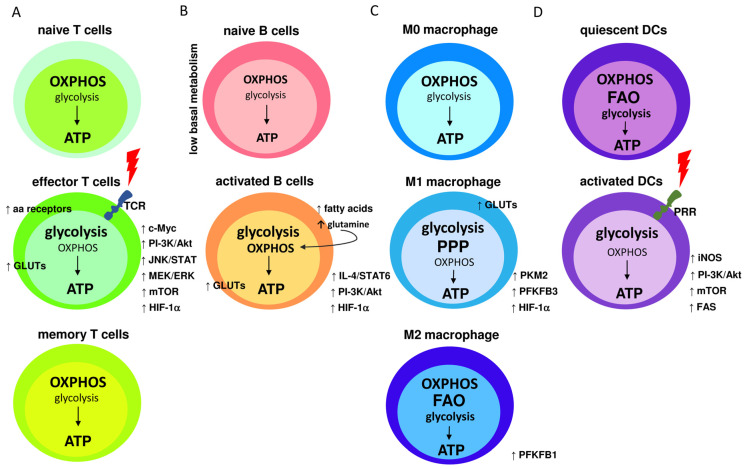Figure 2.
Metabolic characteristics of naive and activated immune cells; (A) naive T cells maintain low rates of glycolysis and predominantly oxidize pyruvate via OXPHOS or engage fatty acid oxidation (FAO) for ATP synthesis. TCR receptor binding triggers T cells’ activation, leading to elevated levels of transmembrane glucose (GLUTs) and amino acids (aa) receptors. TCR signaling also upregulates c-Myc, PI-3K/Akt, JNK/STAT, MEK/ERK, mTOR, and HIF-1α. Consequently, glycolysis becomes the dominant pathway for glucose utilization. In memory T cells, glycolysis rate is downregulated and OXPHOS is the main source of ATP synthesis; (B) naive quiescence B cells exhibit low basal metabolism, with the main participation of the OXPHOS cycle. Activated B cells increase glycolysis rate, which is followed by elevated levels of GLUTs. Glycolytic metabolism is further supported by the activation of HIF-1α, PI-3K/Akt, and IL-4/STAT6 signaling pathways. Regardless of the high glycolysis rate, OHPHOS is still active and incorporates glutamine and fatty acids for more robust ATP synthesis; (C) under normal conditions, naive M0 macrophages obtain energy by efficiently employing OXPHOS. M1 pro-inflammatory macrophages mainly use glycolysis and the pentose phosphate pathways (PPP) to synthesize ATP, whereas the Krebs cycle is disrupted and OXPHOS and FAO processes are downregulated. Metabolic reprogramming activates HIF-1α and GLUTs expression. Also, the levels of the glycolytic enzymes PFKFB3 and PKM2 are elevated. M2 activated macrophages use FAO and OXPHOS as the main metabolic pathways while increasing glucose utilization, however, glycolysis is also elevated in comparison to M0 macrophages; and (D) quiescent DC cells utilize glucose to create pyruvate, which is metabolized in the OXPHOS process. ATP synthesis also occurs through FAO. Upon PRR receptor activation, PI-3K/Akt pathway is activated, leading to increased fatty acids synthesis (FAS) and mTOR activity. PRR activation also induces nitric oxide (NO) production by inducible NO synthase, which stimulates the glycolysis pathway under decreased OXPHOS.

